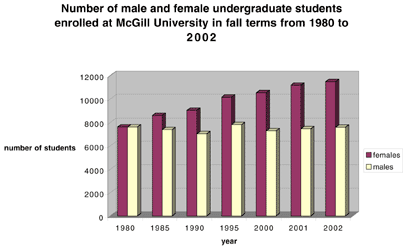Where have all the boys gone?
Men are a minority at McGill, and their numbers are slowly dwindling.
Women now outnumber men by a ratio of three to two at the undergraduate level. No one is certain why this shift has occurred, or how long it may continue, but questions are being asked as to how, or if, this is an issue of concern to the university community.

At the Senate meeting of October 7, Nick de Takacsy, chair of the University Admissions Committee (UAC), presented a report on the gender composition of McGill's students.
Despite the overall downward trend in male enrolment, numbers vary from faculty to faculty and department to department: Dentistry went from 78 percent male in 1980 to 44 percent in 2002, while Music remained almost even over that period. Nursing and Physical and Occupational Therapy both saw jumps in the number of men enroled.
Some of the numbers are not a great surprise: female participation in post-secondary education has been on a steady upswing for the past century.
"There's a very good reason for the increased participation of women in academic life. The question is why is there a decreasing participation of males. And if you can't understand that question, we should at least be able to understand if this has any effect on our academic program," said de Takacsy.
De Takacsy said that he doesn't believe there is any structural discrimination against males in the process that would account for the current trend. Kim Bartlett, the director of admissions, who sat on the UAC workgroup that prepared the report, said that admission to McGill is merit based.
"In a nutshell, McGill admission is based on your grades, and we don't much care where you come from, what you look like, what your religion is, what colour you are, or what gender you are," she said.
When the proposal was first put to Senate in January of this year to study gender composition, there was much opposition. The measure passed by one vote, with six abstentions.
Morton Mendelson, the associate dean of Academic and Student Affairs in the Faculty of Science, put forward that motion and also sat on the workgroup that studied the question.
"I was a little surprised by the reaction to this in Senate. There was a heated exchange -- there were people that were against even looking into the issue. The argument was that the only place this could lead was differential admissions and affirmative action, and we don't want to go there, so let's not even ask the question," he said.
Mendelson said that, if only in terms of diversity, it is important to examine the numbers. As the report pointed out, McGill raised standards for Ontario students in order to ensure geographic diversity when that province's "double cohort" began applying to McGill.
McGill's gender ratio is entirely in keeping with universities in most of the developed world. That said, it is having an effect on McGill's programs in tangible ways.
In Mendelson's faculty, for instance, five women enroled in biology to every one male. In physics, the ratio was three men to every one woman.
This has an effect on how the university uses its resources. Women in the sciences have inflated the relative size of biology -- Bio 200 is the largest class at McGill -- while the decreasing number of men has led to the physical sciences being relatively smaller.
This could affect the pedagogical mission of the university. Hypothetically, Mendelson said certain programs could well benefit from having input from both genders.
"At the graduate level in clinical psychology, if you are going to teach therapists how to deal with problems, some of those are going to be ones men have and you might want a male point of view in the discussion. A clinical psychology class that is 100 percent women could be problematic."
Mendelson suggested a number of ways more men might be attracted to McGill. Accelerating acceptances for male candidates, or offering scholarships in areas where men are under-represented -- an effective strategy used to attract women into engineering faculties -- are possibilities. Even with those measures, however, McGill will still be competing with other universities for a shrinking resource.
The larger problem is the lack of men going to university, which is based in the school system. Education professor Jon Bradley said that the long-term effects of the lack of male teachers -- men make up only 19 percent of the education faculty's enrolment -- is already having an impact in our schools. Some Montreal elementary schools have no men at all on staff.
"I believe that elementary schools are a feminine environment. I'm not saying that's bad or good -- I'm simply making a statement. That feminine environment will determine the learning environment in the schools," said Bradley.
That boys and girls learn differently is fairly well established in educational research. Bradley points out that boys are clearly having problems in the school system before they come to McGill.
"We know that 90 percent of children on Ritalin are boys, and we know that boys are three to four times as likely to drop out of school," he said.
"I believe that we have passed over what anyone could consider to be a normal, regular percentage."
Getting men in the classroom isn't going to make these problems go away, but it might help. Doing so is difficult, for a number of reasons. Male teachers are discouraged from teaching at the elementary level by a number of hurdles. According to Bradley, male teachers are warned to never close a door when they are in classrooms and to never be alone with students. Some schools don't even have proper washroom facilities for male staff.
"There's all kinds of written and unwritten conventions, and there's clearly a double standard. Some men rise to it, others say I don't need this."
Bradley said that the perception that learning is a feminine endeavour may discourage boys from pursuing their education.
Of course nothing is simple. Gender dynamics in university are fluid and complex. Law's shift from 63 percent male in 1980 to 40 percent last year was the largest drop after dentistry. This fall, for the first time in years, incoming men in the faculty outnumber women by a narrow margin.
Although women have represented half the student body of this faculty since the early nineties, the relatively low number of those going on to graduate studies will have an impact on the supply of professors.
This could be due to any number of reasons. One may be that women tend to go straight into the profession. The time commitment of doing postgraduate studies in law may also be a bigger drawback for women.
Even when women do postgraduate studies, it is exceedingly difficult to retain them as professors, because of the attraction of enormously well-paying public service jobs. Law can recruit women, but because governments are under the same kind of pressure to meet gender equity as universities, McGill loses women faster than they can be lured in.

In order to compensate for this trend, the faculty of law has, since 1984, run a mentorship program to encourage female students to pursue postgraduate degrees. Several of the women who have gone through this program have gone on to become professors, and even deans of other law schools.
Although women now make up a substantial majority of the undergraduate population, that numerical superiority has not, as yet, been reflected in graduate studies.
"They've been hovering right around this 50-50 area for a number of years," said Dean of Graduate and Postdoctoral Studies Martha Crago.
Although there is overall equity at the graduate level, as of last year, 60 percent of all PhD candidates at McGill were men, indicating the attrition level for women is higher as the academic level progresses. Crago said she did not know why this might be.
"This stuff needs research. I think we have to be careful. In graduate studies the numbers have reached a very pleasant place -- they're finally what we were hoping they would be, and it's taken 100 years for women to be barely represented to being represented half the time."
The relative lack of female professors in many fields may play a part. Crago pointed to her own academic career, when she was in a department with all male professors.
"I could envision myself as a masters of applied speech pathology, but I really couldn't envision myself as a professor, because I didn't have a model for that, or any particular encouragement. It stopped me for many years -- in fact, it was the first woman professor in the department who asked me, "Why don't you have a PhD?" In my personal experience this was very important to me," she said.
